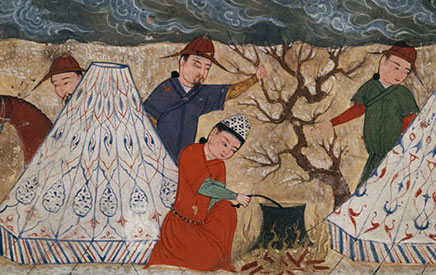
Khubilai Khan and Chabi on a Cookout (detail), Bibliothèque nationale de France, Paris
The reproduction of sheep and goats is essential for the survival of Mongol pastoralism. The animals are culled annually for food, hide, and skin, and many do not survive the harsh winters. Replenishment of the herds and flocks, therefore, is vital. But encouraging successful procreation and survival of the young requires tremendous skill and knowledge.
Another threat to the survival of the sheep and goats are wolves. They generally attacked the young but were also known to threaten adult animals. Herders kept and trained fierce dogs to protect the herds from such predators. In addition, the Mongols periodically went on hunts to cull the wolf population.
Bounty from the Sheep: Autobiography of a Herdsman, by Tserendash Mankhainyambuu, translated from the Mongolian by Mary Rossabi, with introduction by Morris Rossabi (Cambridge: White Horse Press, 2000).